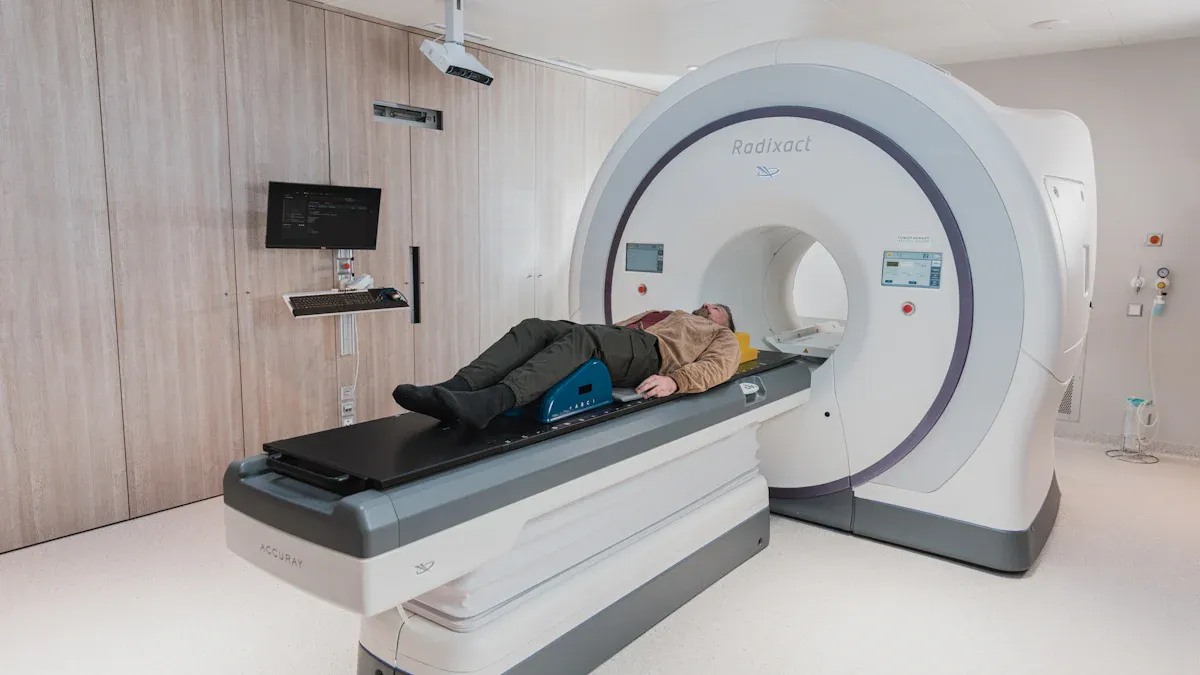What is Liposarcoma and How to Identify Its Symptoms

Liposarcoma is a rare type of cancer that develops in fat cells. It can appear in different parts of your body, but it most often affects the thighs, behind the knees, or the abdomen. Sometimes, it may also occur in the arms or the retroperitoneum, which is the back of the abdominal cavity. This malignant tumor can grow silently, making early detection crucial. If you notice unusual lumps or swelling in these areas, consult a healthcare professional promptly. Early diagnosis increases the chances of effective treatment and better outcomes.
Key Takeaways
Liposarcoma is a rare cancer that starts in fat cells. It is often found in the thighs, belly, or behind the knees. Finding it early helps with better treatment.
Common signs include a lump that doesn’t hurt, swelling, or general symptoms like fever or losing weight. Watch for any strange changes in your body.
Surgery is the main way to treat liposarcoma. Radiation is often added to stop it from coming back. For serious cases, chemotherapy might be used.
Knowing how liposarcoma is different from harmless lumps like lipomas is important. Liposarcomas feel harder and can grow bigger.
Things like genes or past radiation exposure can raise the chance of getting liposarcoma. Regular doctor visits can help find it early.
What is Liposarcoma?

Definition and Characteristics
Liposarcoma is a malignant tumor that develops in fat cells, often within the soft tissues of your body. It can occur in areas like the thighs, abdomen, or behind the knees. This type of cancer is known for its potential to grow aggressively and return after treatment. Its classification depends on how the tumor cells appear under a microscope and their growth rate. Vigilant management is essential to address its recurrence and spread effectively.
Types of Liposarcoma
Liposarcoma has several subtypes, each with unique characteristics:
Well-Differentiated Liposarcoma: The most common and slow-growing subtype. It rarely spreads but may regrow after treatment.
Myxoid Liposarcoma: This subtype grows slowly but has a higher risk of spreading to distant areas, such as the lungs.
Dedifferentiated Liposarcoma: A more aggressive form that often develops from well-differentiated liposarcoma.
Round Cell Liposarcoma: A variant of myxoid liposarcoma, typically found in the thigh.
Pleomorphic Liposarcoma: The rarest and most aggressive subtype, with a high likelihood of recurrence and spreading.
Understanding these subtypes helps you recognize the severity and treatment options for each case.
How Liposarcoma Differs from Lipoma
You might confuse liposarcoma with lipoma, a benign tumor made of fat cells. However, there are key differences:
Lipomas feel soft and rubbery, while liposarcomas are firmer.
Lipomas grow just beneath the skin, but liposarcomas develop deeper in tissues.
Lipomas are usually small, no larger than 2 inches, whereas liposarcomas can grow much larger.
Lipoma (Benign) | Liposarcoma (Malignant) | |
|---|---|---|
Nature | Noncancerous | Cancerous |
Commonality | More common, affecting 2 in 1,000 | Less common, 1,700 diagnosed yearly |
Symptoms | Typically asymptomatic | Can cause pain or discomfort |
Consistency | Soft and rubbery | Usually firmer |
Location | Just below the skin | Deeper in tissues |
Size | Generally no larger than 2 inches | Can grow much larger |
Liposarcomas also tend to affect middle-aged adults and may spread to other organs, such as the lungs or liver. Recognizing these differences can help you seek timely medical advice.
Symptoms of Liposarcoma

Common Symptoms
Liposarcoma often begins without noticeable symptoms. You may not feel any discomfort in the early stages. However, as the tumor grows, it can cause a painless lump in the affected area. This lump may feel firm and increase in size over time. Other nonspecific symptoms include fever, night sweats, and unexplained weight loss.
In some cases, you might experience pain or discomfort if the tumor presses on nearby nerves or tissues. Larger tumors can even lead to neurological issues, such as numbness or weakness in the affected area. If you notice any unusual swelling or lumps, it’s important to consult a healthcare professional promptly. Early detection can significantly improve treatment outcomes.
Location-Specific Symptoms
The symptoms of liposarcoma vary depending on where the tumor develops in your body. For example:
Arms or Legs: You may notice a growing lump that is usually painless. Swelling or weakness in the affected limb can also occur.
Abdomen: Tumors in this area often cause stomach pain, constipation, or a feeling of fullness after eating small amounts. You might also experience nausea, swelling, or unintended weight loss.
Esophagus: If the tumor is located here, you could have trouble swallowing or lose weight unintentionally.
The table below highlights how symptoms differ based on the tumor’s location:
Location | Symptoms |
|---|---|
Abdomen | Constipation, nausea, pain, swelling, unintended weight loss, vomiting, feeling full sooner. |
Arms/Legs | Growing lump, swelling, pain, or weakness in the affected limb. |
Esophagus | Trouble swallowing, unintended weight loss. |
Liposarcoma in the abdomen may remain unnoticed until the tumor grows large enough to press on surrounding organs. In contrast, tumors in the limbs are often detected earlier due to visible swelling or lumps. Paying attention to these location-specific symptoms can help you identify potential warning signs early.
Causes and Risk Factors of Liposarcoma
Potential Causes
Liposarcoma develops when fat cells undergo abnormal changes that lead to uncontrolled growth. These changes often result from genetic mutations. Some inherited conditions also increase your risk of developing this cancer. These include:
Gardner syndrome: This condition causes polyps and tumors to form in the colon and other parts of the body.
Li-Fraumeni syndrome: A rare disorder that raises the likelihood of various cancers, including liposarcoma.
Werner syndrome: This condition accelerates aging and increases the risk of certain cancers.
Environmental factors can also play a role. Prior exposure to radiation, such as from cancer treatments, may trigger liposarcoma. Occupational exposure to industrial chemicals like vinyl chloride is another potential cause.
Risk Factors
Several factors may increase your chances of developing liposarcoma. These include:
Genetic predispositions: Conditions like Gardner syndrome, Li-Fraumeni syndrome, and Werner syndrome can heighten your risk.
Radiation exposure: If you have undergone radiation therapy for another cancer, your risk may be higher.
Chemical exposure: Working with chemicals such as vinyl chloride can increase your risk.
Family history also plays a significant role. If you have relatives with inherited conditions like Gardner syndrome or Li-Fraumeni syndrome, you may face a higher risk of developing liposarcoma.
By understanding these causes and risk factors, you can take proactive steps to monitor your health and consult a healthcare professional if needed.
Diagnosing Liposarcoma
Initial Diagnostic Steps
Diagnosing liposarcoma begins with a thorough evaluation of your symptoms and medical history. A healthcare provider will examine the affected area for lumps or swelling. They may ask about any discomfort, changes in size, or other unusual signs. Imaging studies play a crucial role in identifying the tumor and assessing its characteristics.
The table below highlights the effectiveness of different imaging techniques:
Imaging Technique | Effectiveness | Notes |
|---|---|---|
CT Scan | High | Essential for preoperative evaluation and distinguishing tumors. |
MRI | Moderate | Useful for identifying myxoid liposarcomas but not always definitive. |
PET Scan | Promising | Shows potential for detection but is not widely used. |
Plain Radiographs | Low | Confirms the presence of a mass but lacks specificity. |
Ultrasonography | Moderate | Helps confirm a mass when other methods are inconclusive. |
CT scans and MRIs are the most commonly used tools. They provide detailed images of the tumor's size, location, and relationship to nearby tissues. If imaging suggests a suspicious mass, your doctor may recommend a biopsy to confirm the diagnosis.
Liposarcomas can resemble benign tumors like lipomas, making imaging alone insufficient. A biopsy ensures accurate identification and guides treatment planning.
Confirming the Diagnosis
Confirming liposarcoma requires a biopsy. During this procedure, a small tissue sample is taken from the tumor and analyzed under a microscope. This step determines whether the tumor is benign or malignant.
Here’s how the diagnostic process typically unfolds:
Pathologists examine the sample for cancerous cells.
Additional tests may determine the tumor's subtype and stage.
CT scans and MRIs also help confirm the diagnosis by providing insights into the tumor's characteristics. These imaging techniques reveal the extent of the tumor and its potential spread to other areas.
Doctors emphasize the importance of an experienced team for interpreting biopsy results. Accurate diagnosis depends on combining imaging findings with histopathological analysis.
Differentiating liposarcoma from other soft tissue tumors can be challenging. Some benign tumors, like lipomas, share similar symptoms and imaging features. Histopathological examination and molecular testing are essential for accurate classification.
Early detection improves outcomes. If you notice unusual lumps or swelling, seek medical advice promptly. A comprehensive approach, including imaging and biopsy, ensures timely and accurate diagnosis.
Treatment Options for Liposarcoma
Surgical Treatments
Surgery is the primary treatment for liposarcoma, especially when the tumor is localized. Doctors aim to remove the tumor completely, but this can be challenging if it is near vital organs. Surgical resection is most effective for retroperitoneal dedifferentiated liposarcoma (DDL). However, even after surgery, there is a risk of recurrence.
Radiation therapy often complements surgery. It can shrink the tumor before surgery or eliminate remaining cancer cells afterward. This approach reduces the chances of the cancer returning. Chemotherapy may also be used in advanced cases, though its effectiveness depends on the specific situation.
Treatment Option | Effectiveness |
|---|---|
Surgical Resection | |
Radiation Therapy | Used post-surgery to reduce recurrence; effectiveness varies based on individual cases. |
Chemotherapy | Plays a role in managing advanced disease; effectiveness is context-dependent. |
Note: Surgery carries risks such as pain, infection, or damage to nearby organs. Discuss these risks with your healthcare provider to make informed decisions.
Non-Surgical Treatments
Non-surgical treatments play a crucial role in managing liposarcoma, especially when surgery is not feasible. Radiation therapy is commonly used to shrink tumors before surgery or to reduce recurrence risk afterward. It is particularly effective for myxoid liposarcomas.
Chemotherapy is another option, especially for advanced or metastatic liposarcoma. Drugs like doxorubicin and ifosfamide help slow tumor growth and manage symptoms. Targeted therapies, such as pazopanib, are emerging as promising options for advanced cases. Additionally, trabectedin and eribulin have shown benefits in treating unresectable or metastatic liposarcoma.
Radiation Therapy: Shrinks tumors pre-surgery and reduces recurrence risk post-surgery.
Chemotherapy: Effective for advanced cases, using drugs like doxorubicin and ifosfamide.
Targeted Therapies: Focus on specific molecular targets, offering hope for advanced liposarcoma.
Emerging Therapies
Research continues to explore new treatments for liposarcoma. Clinical trials are testing innovative drugs and combinations to improve outcomes. For example, abemaciclib has shown promise in prolonging progression-free survival for patients with dedifferentiated liposarcoma. Other therapies, such as ribociclib combined with everolimus, are being studied for advanced cases.
Therapy/Drug | Phase | Description |
|---|---|---|
Abemaciclib | II | Prolonged median progression-free survival of 30.4 weeks in DDL patients. |
Ribociclib + Everolimus | II | Combination therapy for advanced DDL or leiomyosarcoma. |
Milademetan | III | Evaluating safety and efficacy compared to trabectedin in unresectable or metastatic DDL. |
These emerging therapies offer hope for patients with advanced or resistant forms of liposarcoma. Participating in clinical trials may provide access to cutting-edge treatments.
Understanding liposarcoma can help you recognize its symptoms and seek timely treatment. Key symptoms include a painless mass, nonspecific signs like fever or weight loss, and discomfort based on the tumor's location. Neurological issues may arise if the tumor compresses nearby structures. Treatment often involves:
Surgical removal as the primary approach
Radiation therapy to reduce recurrence
Chemotherapy for advanced cases
Early detection plays a vital role in improving outcomes. If you notice unusual lumps or persistent symptoms, consult a healthcare provider. Staying informed empowers you to take control of your health and act proactively.
FAQ
What is the difference between liposarcoma and other soft tissue cancers?
Liposarcoma originates in fat cells, while other soft tissue cancers may develop in muscles, nerves, or blood vessels. Each type has unique characteristics and treatment approaches. Identifying the specific cancer type helps doctors create an effective treatment plan.
Can liposarcoma spread to other parts of the body?
Yes, liposarcoma can metastasize, especially aggressive subtypes like pleomorphic or dedifferentiated liposarcoma. Common areas include the lungs or liver. Early detection and treatment reduce the risk of spreading.
Is liposarcoma hereditary?
Some genetic conditions, like Li-Fraumeni syndrome, increase your risk of liposarcoma. However, most cases are not inherited. Discuss your family history with a doctor to assess your risk.
How can you differentiate liposarcoma from a benign lipoma?
Liposarcomas are firmer, grow deeper in tissues, and can become larger than lipomas. Lipomas are soft, rubbery, and usually painless. A biopsy confirms the diagnosis.
Are there lifestyle changes that help prevent liposarcoma?
There are no guaranteed prevention methods. However, avoiding radiation exposure and harmful chemicals may lower your risk. Regular check-ups and monitoring unusual lumps can aid early detection.
---
ℹ️ Explore more: Read our Comprehensive Guide to All Known Cancer Types for symptoms, causes, and treatments.
See Also
Understanding Chondrosarcoma: Recognizing Its Symptoms and Effects
Exploring Fibrosarcoma: Essential Traits and Features Explained
An Overview of Angiosarcoma: Definition and Insights
Identifying Angioimmunoblastic T-Cell Lymphoma: Symptoms and Signs
